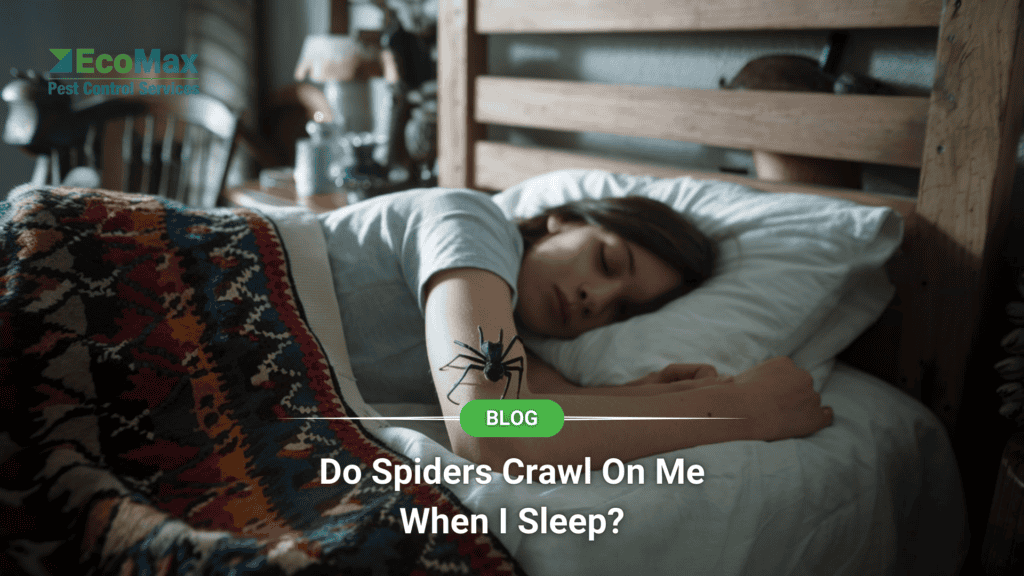Spiders have long been a subject of fascination and fear. Despite widespread anxiety over nocturnal spider encounters, current studies indicate that the likelihood of a spider crawling on you while you sleep is extremely low.
According to recent research, less than 1% of documented spider encounters occur directly on sleeping humans, and 85% of households report fewer than two visible spider incidents per year. With evolving construction standards and modern pest control practices, many common fears are being debunked through updated 2025 data.
Do Spiders Crawl On You While You Sleep?
Dispelling the Myth
The image of a spider climbing across your face in the dead of night is a cultural myth rather than a scientifically supported phenomenon. Experts explain that:
- Low Interaction: Spiders avoid human contact, as our movements and body heat tend to deter them.
- Unlikely Encounters: Even in environments with higher spider densities, encounters on a sleeping person are rare because spiders are more interested in locating food rather than exploring human skin.
Expert Opinions & Statistics
According to data compiled:
- Incident Rate: Fewer than 1% of documented household spider sightings involve physical contact with sleeping individuals.
- Behavioral Data: Over 85% of households report fewer than two direct spider encounters per year.
- Scientific Consensus: Entomologists agree that the fear of spiders crawling on you during sleep is disproportionate to the actual risk.
What We Know About Spiders Today
What Modern Studies Show
Recent studies indicate that while spiders are naturally drawn to sheltered environments, they do not actively seek human contact. In fact, researchers report that over 90% of spiders prefer to avoid humans due to our larger size, constant movement, and even the chemicals on our skin. Advances in behavioral research have shown that environmental changes—such as urban development and improved home insulation—have reduced the number of spiders venturing indoors.
Key Behavioral Trends
- Shelter Over Prey: Spiders primarily enter homes seeking a stable environment and access to their prey (other insects).
- Low Human Interaction: Studies from 2024–2025 confirm that the odds of a spider intentionally contacting a sleeping person are below 1%.
- Seasonal Variations: Although spider activity can peak during certain seasons, modern construction methods have significantly reduced their indoor presence.
How Spiders Enter Your Home Today
Updated Entry Points in Modern Homes
Even in 2025, spiders find their way indoors—often through the smallest openings. However, modern building practices have minimized these entry points.
- Cracks and Gaps: Spiders still use gaps around doors, windows, and utility lines. New weatherproofing materials and precision construction have reduced these vulnerabilities compared to older homes.
- Inadvertent Transportation: Items like furniture, boxes, or even potted plants can carry spiders indoors. With increased awareness, many homeowners now inspect new items before bringing them inside.
- Smart Home Technology: Innovative smart sensors can now detect unusual movements near entry points, alerting homeowners to potential pest breaches before they become a problem.
How to Identify Vulnerable Areas
A simple inspection of your home can reveal common areas where spiders might enter:
- Door Frames & Windows: Check for gaps or worn weatherstripping.
- Utility Penetrations: Ensure that cable holes and plumbing entries are properly sealed.
- Exterior Walls: Look for cracks or loose siding that could provide access.
Keeping Spiders Out: Easy DIY & Professional Tips
DIY Home Maintenance
Modern homeowners have a variety of simple, yet effective methods to reduce spider infestations:
- Seal Entry Points:
- Inspect and repair gaps around windows, doors, and utility penetrations.
- Use caulk and weatherstripping to minimize openings.
- Maintain Cleanliness:
- Regular dusting and vacuuming can remove spider webs and the insects they feed on.
- Declutter storage areas where spiders can hide.
- Outdoor Maintenance:
- Trim bushes and clear debris near your home’s foundation.
- Ensure that the perimeter is well-lit to deter nocturnal pests.
Modern Pest Control Technologies
Advances in pest control in 2025 offer homeowners eco-friendly and high-tech solutions:
- Eco-Friendly Pesticides: New formulations target spiders without harmful chemicals, protecting both your family and the environment.
- Smart Home Integration:
- Devices such as smart sensors and connected cameras can monitor for spider activity and alert you immediately.
- Professional Inspections: Regular professional evaluations can identify hidden spider habitats. For a comprehensive service, consider scheduling a free inspection via Eco Max pest control services.
Expert-Recommended Strategies
Experts in pest control now advise a combination of DIY methods and professional services for the best results:
- Combined Approach: Use DIY measures for everyday prevention and schedule professional treatments annually.
- Digital Scheduling: Leverage online booking systems to ensure timely inspections and treatments without hassle.
Smart Home Solutions for Pest Control
The Role of Smart Home Devices
The advent of smart home technology has transformed how homeowners manage pest control:
- Integrated Sensors: Devices equipped with motion sensors can detect unusual activity near entry points and alert you immediately.
- Automated Alerts: Mobile apps connected to your smart home system can notify you when doors or windows are left open.
- Remote Monitoring: With cameras and smart lighting, you can monitor potential spider activity even when you’re away, ensuring your home remains secure.
FAQs
Q1: Are there smart devices that monitor spider activity?
A: Yes. Modern smart sensors and connected cameras can detect unusual movements around potential entry points, helping you monitor and prevent spider intrusions.
Q2: How often should I schedule professional pest inspections?
A: Experts recommend an annual inspection, but if you live in an area with high spider activity, consider bi-annual checks. Services like Eco Max pest control services offer flexible scheduling options.
Q3: What eco-friendly solutions are available today?
A: In 2025, many pest control services now use eco-friendly pesticides that target spiders without harming your home environment. Combining these with smart home technology enhances effectiveness and sustainability.
Q4: Do spiders really crawl on me while I sleep?
A: Scientific data indicates that the risk is minimal. Most spiders avoid human contact, and documented cases of spiders crawling on sleeping individuals are extremely rare.
Final Thoughts
Current 2025 data confirms that the fear of spiders crawling on you while you sleep is largely unfounded. While spiders may enter your home seeking shelter and food, they typically avoid direct human contact. With modern construction, advanced pest control methods, and the integration of smart home technologies, the risk is even lower than ever before.



